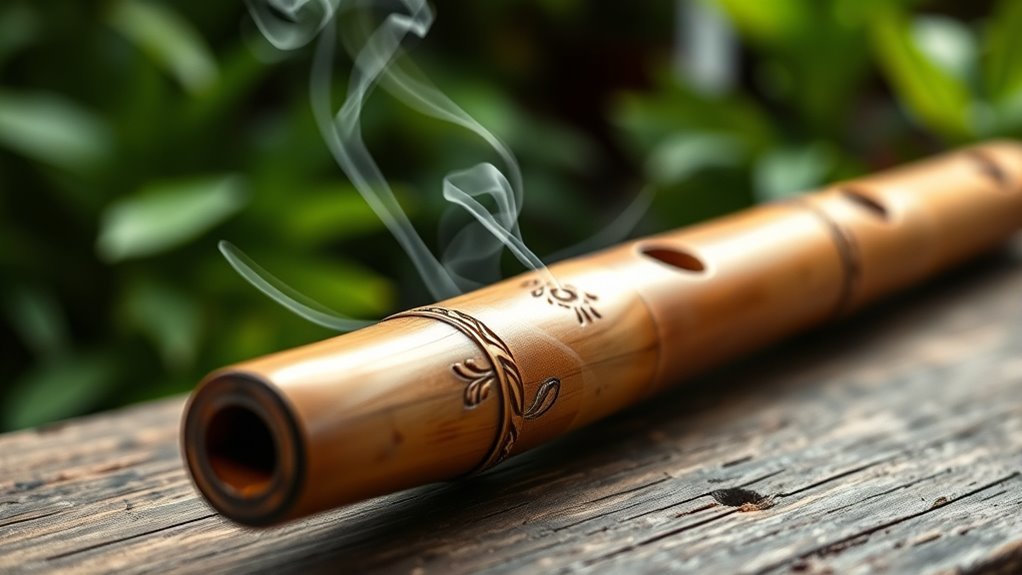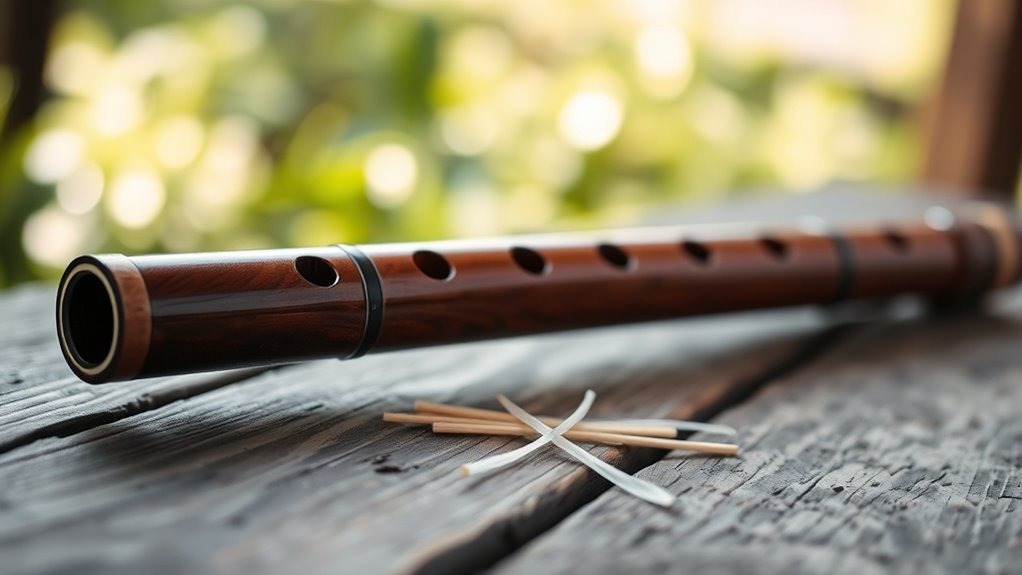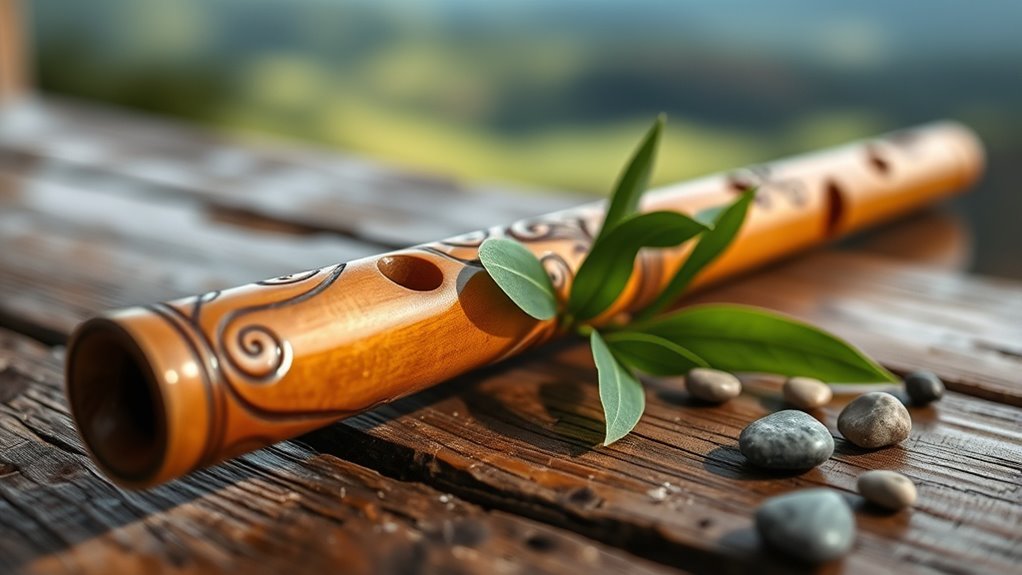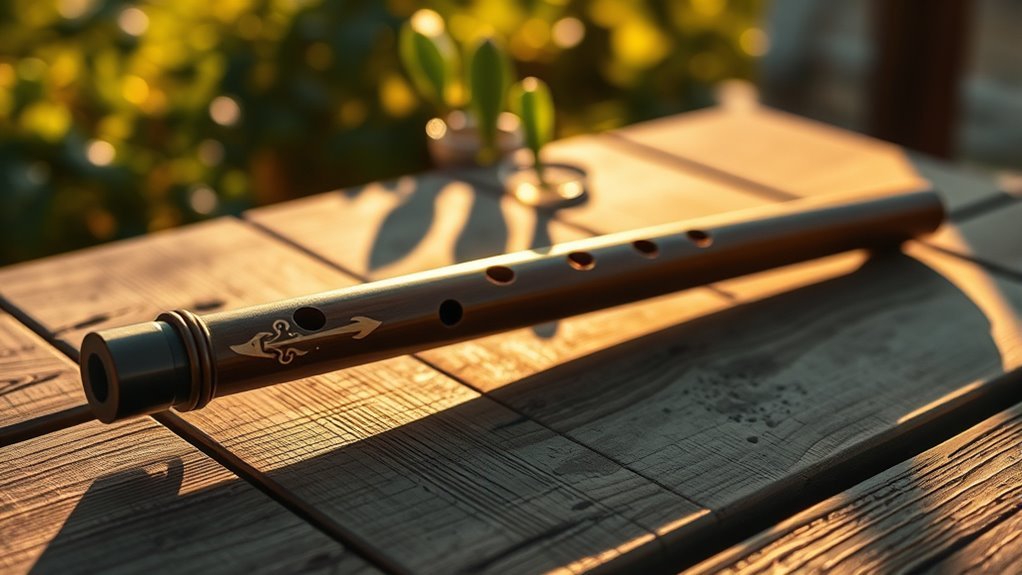A drone flute is a unique musical instrument designed to produce sustained tones, providing rich atmospheric soundscapes. Its construction typically involves a three-part system: body, mouthpiece, and drone chamber, crafted from materials like wood or metal, which greatly influence tonal quality. Playing techniques emphasize breath control and finger positioning, enhancing sound production. Drone flutes play a significant role in various musical genres and offer therapeutic benefits, fostering emotional well-being and creative flow. Explore further to uncover more about this fascinating instrument.
The History of the Drone Flute

While many instruments have evolved over centuries, the drone flute’s history stands out due to its unique role in various musical traditions. Its ancient origins trace back to civilizations that embraced sound as a means of connection and expression. The drone flute’s simplicity and harmonic richness allowed it to transcend geographical boundaries, influencing cultural evolution across regions. As you explore its lineage, you’ll notice how it served not just as a musical tool but as a ritualistic instrument, integral to ceremonies and communal gatherings. The adaptability of the drone flute has fostered its continual reinvention, reflecting the diverse artistic landscapes it inhabits. By understanding its past, you gain insight into the profound ways music shapes human experience and identity.
How Drone Flutes Are Constructed

Constructing a drone flute typically involves three main components: the body, the mouthpiece, and the drone chamber. The body is crafted from materials like wood or metal, influencing the instrument’s tonal quality and resonance. Precision in shaping this component is crucial to achieving the desired sound. The mouthpiece, where you blow air, must be designed for ideal airflow and comfort, reflecting skilled drone flute craftsmanship. Finally, the drone chamber houses the reed or air mechanism, creating the sustained sound characteristic of drone flutes. Understanding drone flute anatomy is essential for makers aiming to produce instruments that not only function well but also resonate with freedom and expression, allowing musicians to explore their creativity unbounded.
Distinguishing Features of Drone Flutes

When examining drone flutes, you’ll notice distinct features in their construction materials and design, which greatly influence their tonal quality. The sound production mechanism also plays a critical role, as it determines how effectively the instrument can create sustained notes. Additionally, understanding the cultural significance and use of drone flutes provides context for their unique characteristics across different musical traditions.
Construction Materials and Design
Although the construction materials and design of drone flutes may vary widely, they share several distinguishing features that define their unique sound and functionality. You’ll find that wood types like bamboo, maple, and mahogany play an essential role in sound quality and resonance. Each wood type not only affects tonal characteristics but also influences the instrument’s durability and aesthetic appeal. The design aesthetics of drone flutes often emphasize simplicity, with sleek lines and ergonomic shapes that enhance playability. These elements combine to create a visually striking instrument that doesn’t compromise on performance. By understanding these materials and design principles, you can appreciate how they contribute to the overall experience of playing and listening to drone flutes.
Sound Production Mechanism
The sound production mechanism of drone flutes is characterized by their unique approach to generating harmonious tones that resonate with a continuous drone. You’ll notice how these instruments utilize specific features to create rich sound waves and achieve acoustic resonance. Key elements include:
- Dual-chamber design: This enhances the depth and fullness of sound produced.
- Reed or mouthpiece: Essential for initiating sound waves, allowing for varied tonal qualities.
- Tuning holes: These adjust pitch, enabling a more versatile range of notes.
- Material selection: Different materials influence timbre, contributing to the flute’s overall acoustic properties.
Cultural Significance and Use
While many musical instruments carry cultural significance, drone flutes stand out due to their distinctive role in various traditions worldwide. These instruments serve as essential conduits for cultural expressions, often accompanying traditional rituals that reinforce community bonds and spiritual beliefs. You’ll find them in ceremonies ranging from Native American powwows to Indian classical music, where their sustained tones create a meditative backdrop, inviting introspection and connection. The drone flute’s ability to produce continuous sound fosters an environment conducive to ritualistic practices, allowing participants to transcend the mundane. Its unique construction and sound production techniques reflect the innovative spirit of diverse cultures, making it not just an instrument, but a symbol of heritage and collective identity.
Playing Techniques for Drone Flutes
When mastering the art of playing drone flutes, you’ll find that a combination of breath control and finger positioning is crucial for producing a rich, sustained sound. To elevate your technique, focus on the following strategies:
- Breath Control: Practice varying your airflow to achieve dynamic contrasts.
- Finger Positioning: Guarantee your fingers cover the holes completely to avoid air leaks.
- Rhythmic Variations: Incorporate different rhythms to create engaging melodies alongside the drone.
- Posture and Relaxation: Maintain a relaxed posture to facilitate smooth airflow and reduce tension.
Musical Genres Utilizing Drone Flutes
Throughout various musical genres, drone flutes play a pivotal role in creating atmospheric soundscapes and establishing tonal foundations. These instruments are adept at blending ethnic influences with intricate rhythmic patterns, fostering a unique auditory experience. Here’s a concise overview of some genres where drone flutes thrive:
| Genre | Key Characteristics |
|---|---|
| Folk | Emphasizes traditional ethnic influences, storytelling through melody. |
| Ambient | Focuses on creating immersive soundscapes, often using long sustained notes. |
| World Music | Incorporates diverse cultural elements, enhancing global musical dialogue. |
| Minimalism | Utilizes repetitive structures, allowing drone flutes to establish a hypnotic feel. |
In these genres, the drone flute’s resonance enhances both emotional depth and cultural expression, inviting listeners to explore a world of sonic freedom.
The Role of Drone Flutes in Contemporary Music
As musical genres evolve, the role of drone flutes in contemporary music becomes increasingly significant. These instruments add a rich layer of texture and harmony, enhancing the sonic landscape in ways that resonate with both performers and audiences. In contemporary music, you’ll find drone flutes enriching:
- Experimental compositions that challenge traditional structures
- Collaborative performances that blend diverse musical backgrounds
- Meditative soundscapes promoting introspection and emotional depth
- Electronic music, where their unique timbres mesh with digital elements
The integration of drone flutes invites innovative exploration, fostering creative freedom. As artists continue to push boundaries, these flutes serve as a bridge between ancient traditions and modern experimentation, forging new paths in the ever-evolving musical narrative.
Notable Drone Flute Artists and Composers
While many musicians utilize a variety of instruments, a select group of artists has mastered the drone flute, pushing the boundaries of its sound and application. Among these famous drone artists, you’ll find innovators like Tenzin Choegyal and his unique fusion of traditional Tibetan influences with contemporary soundscapes. Their influential compositions often explore the interplay between sustained tones and rhythmic patterns, creating immersive auditory experiences. Similarly, composers like Steve Reich have incorporated drone elements into minimalistic works, highlighting the flute’s versatility. These artists not only elevate the drone flute’s status but also inspire new generations to experiment with its sonic potential, fostering a deeper understanding of its role in both modern and traditional music landscapes.
The Therapeutic Benefits of Drone Flute Music
You may find that drone flute music possesses unique sound healing properties that can enhance your well-being. By engaging with its resonant tones, you could effectively utilize stress reduction techniques that promote relaxation and mental clarity. Exploring these therapeutic benefits offers a compelling avenue for personal growth and emotional balance.
Sound Healing Properties
Recent studies have shown that drone flute music can greatly enhance emotional well-being and promote relaxation. Its unique sound frequencies and healing vibrations resonate deeply within you, fostering a sense of harmony. Engaging with this music allows for profound personal exploration and transformation. Here are some key benefits:
- Enhanced Mood: Elevates emotional states through soothing soundscapes.
- Mindfulness Promotion: Encourages present-moment awareness and mental clarity.
- Energetic Alignment: Balances the body’s energy centers, promoting overall wellness.
- Creative Flow: Stimulates inspiration and innovative thinking.
Stress Reduction Techniques
The therapeutic benefits of drone flute music extend beyond emotional well-being, offering effective stress reduction techniques. Integrating this music into your mindfulness meditation practice can enhance focus and promote a serene mental state. The sustained tones create a calming atmosphere, allowing your mind to release tension and cultivate present-moment awareness.
Simultaneously, pairing drone flute melodies with deep breathing exercises amplifies relaxation. As you inhale deeply, the resonant sounds help synchronize your breath, fostering a sense of harmony within. This synergy not only alleviates stress but also encourages emotional liberation, enabling you to break free from negative thought patterns. By embracing these techniques, you can harness the transformative power of drone flute music, ultimately enhancing your overall well-being.
Future Trends in Drone Flute Innovation
As technology advances, the potential for drone flute innovation becomes increasingly promising. You can expect future developments to leverage cutting-edge future technologies and innovative materials, enhancing both functionality and accessibility. Here are some trends to watch for:The future of drone flutes promises innovative technologies and materials, enhancing both creativity and accessibility for musicians.
- Smart Sensors: Integration of sensors for real-time tuning and sound modulation.
- Eco-friendly Materials: Use of sustainable materials that improve acoustics without compromising the environment.
- Modular Designs: Customizable components allowing players to create personalized soundscapes.
- AI Integration: Machine learning algorithms for composing and enhancing drone flute music.
These advancements will not only elevate the artistic experience but also empower musicians, granting them greater freedom in their creative expressions. The future of drone flutes is bright and filled with endless possibilities.
Frequently Asked Questions
Can Drone Flutes Be Made From Different Materials?
Absolutely, you can craft drone flutes from various material types like wood, metal, or plastic. Each construction technique influences sound quality, creating unique tonal textures that resonate deeply, giving you the freedom to explore diverse musical landscapes.
Are There Specific Maintenance Tips for Drone Flutes?
When maintaining your drone flute, prioritize cleaning techniques to avoid buildup. Regularly check tuning tips to guarantee peak sound quality. This attention to detail enhances your playing experience and allows for greater artistic freedom.
How Do Drone Flutes Compare to Traditional Flutes?
Imagine a bridge connecting ancient traditions and modern sounds; drone flutes offer unique musical styles with rich drone flute history. Compared to traditional flutes, they emphasize sustained tones, allowing for innovative expression and greater freedom in composition.
What Age Is Appropriate for Learning the Drone Flute?
When considering age for learning the drone flute, it’s essential to align with child development milestones. Typically, ages 7-10 are ideal, fostering musical education while promoting cognitive skills and creative expression, allowing children freedom in their musical journey.
Are There Online Resources for Drone Flute Tutorials?
Imagine traversing a vast ocean of knowledge; you’ve got online classes and video lessons waiting to guide you. With just a few clicks, you’ll discover the freedom to master your drone flute journey effortlessly.

